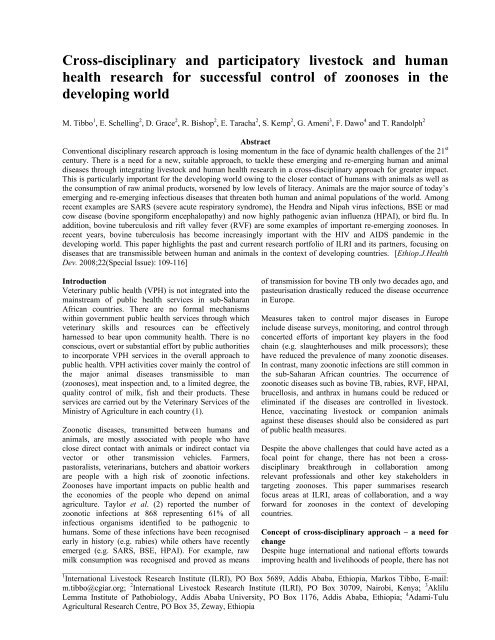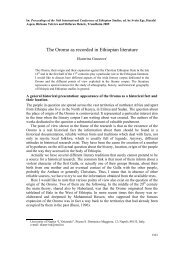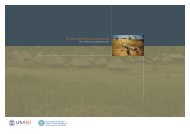You also want an ePaper? Increase the reach of your titles
YUMPU automatically turns print PDFs into web optimized ePapers that Google loves.
Cross-disciplinary and participatory livestock and human<br />
health research for successful control of zoonoses in the<br />
developing world<br />
M. Tibbo 1 , E. Schelling 2 , D. Grace 2 , R. Bishop 2 , E. Taracha 2 , S. Kemp 2 , G. Ameni 3 , F. Dawo 4 and T. Randolph 2<br />
Abstract<br />
Conventional disciplinary research approach is losing momentum in the face of dynamic health challenges of the 21 st<br />
century. There is a need for a new, suitable approach, to tackle these emerging and re-emerging human and animal<br />
diseases through integrating livestock and human health research in a cross-disciplinary approach for greater impact.<br />
This is particularly important for the developing world owing to the closer contact of humans with animals as well as<br />
the consumption of raw animal products, worsened by low levels of literacy. Animals are the major source of today’s<br />
emerging and re-emerging infectious diseases that threaten both human and animal populations of the world. Among<br />
recent examples are SARS (severe acute respiratory syndrome), the Hendra and Nipah virus infections, BSE or mad<br />
cow disease (bovine spongiform encephalopathy) and now highly pathogenic avian influenza (HPAI), or bird flu. In<br />
addition, bovine tuberculosis and rift valley fever (RVF) are some examples of important re-emerging zoonoses. In<br />
recent years, bovine tuberculosis has become increasingly important with the HIV and AIDS pandemic in the<br />
developing world. This paper highlights the past and current research portfolio of ILRI and its partners, focusing on<br />
diseases that are transmissible between human and animals in the context of developing countries. [Ethiop.J.Health<br />
Dev. <strong>2008</strong>;22(Special Issue): 109-116]<br />
Introduction<br />
Veterinary public health (VPH) is not integrated into the<br />
mainstream of public health services in sub-Saharan<br />
African countries. There are no formal mechanisms<br />
within government public health services through which<br />
veterinary skills and resources can be effectively<br />
harnessed to bear upon community health. There is no<br />
conscious, overt or substantial effort by public authorities<br />
to incorporate VPH services in the overall approach to<br />
public health. VPH activities cover mainly the control of<br />
the major animal diseases transmissible to man<br />
(zoonoses), meat inspection and, to a limited degree, the<br />
quality control of milk, fish and their products. These<br />
services are carried out by the Veterinary Services of the<br />
Ministry of Agriculture in each country (1).<br />
Zoonotic diseases, transmitted between humans and<br />
animals, are mostly associated with people who have<br />
close direct contact with animals or indirect contact via<br />
vector or other transmission vehicles. Farmers,<br />
pastoralists, veterinarians, butchers and abattoir workers<br />
are people with a high risk of zoonotic infections.<br />
Zoonoses have important impacts on public health and<br />
the economies of the people who depend on animal<br />
agriculture. Taylor et al. (2) reported the number of<br />
zoonotic infections at 868 representing 61% of all<br />
infectious organisms identified to be pathogenic to<br />
humans. Some of these infections have been recognised<br />
early in history (e.g. rabies) while others have recently<br />
emerged (e.g. SARS, BSE, HPAI). For example, raw<br />
milk consumption was recognised and proved as means<br />
of transmission for bovine TB only two decades ago, and<br />
pasteurisation drastically reduced the disease occurrence<br />
in Europe.<br />
Measures taken to control major diseases in Europe<br />
include disease surveys, monitoring, and control through<br />
concerted efforts of important key players in the food<br />
chain (e.g. slaughterhouses and milk processors); these<br />
have reduced the prevalence of many zoonotic diseases.<br />
In contrast, many zoonotic infections are still common in<br />
the sub-Saharan African countries. The occurrence of<br />
zoonotic diseases such as bovine TB, rabies, RVF, HPAI,<br />
brucellosis, and anthrax in humans could be reduced or<br />
eliminated if the diseases are controlled in livestock.<br />
Hence, vaccinating livestock or companion animals<br />
against these diseases should also be considered as part<br />
of public health measures.<br />
Despite the above challenges that could have acted as a<br />
focal point for change, there has not been a crossdisciplinary<br />
breakthrough in collaboration among<br />
relevant professionals and other key stakeholders in<br />
targeting zoonoses. This paper summarises research<br />
focus areas at ILRI, areas of collaboration, and a way<br />
forward for zoonoses in the context of developing<br />
countries.<br />
Concept of cross-disciplinary approach – a need for<br />
change<br />
Despite huge international and national efforts towards<br />
improving health and livelihoods of people, there has not<br />
_______________________________________________________________________________________________<br />
1 International Livestock Research Institute (ILRI), PO Box 5689, Addis Ababa, Ethiopia, Markos Tibbo, E-mail:<br />
m.tibbo@cgiar.org; 2 International Livestock Research Institute (ILRI), PO Box 30709, Nairobi, Kenya; 3 Aklilu<br />
Lemma Institute of Pathobiology, Addis Ababa University, PO Box 1176, Addis Ababa, Ethiopia; 4 Adami-Tulu<br />
Agricultural Research Centre, PO Box 35, Zeway, Ethiopia







